B0041VYHGW EBOK (27 page)
Authors: David Bordwell,Kristin Thompson

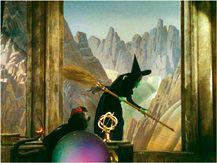
2.12 … the Witch’s broom in Oz.
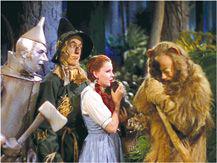
2.13 As the Lion describes his timidity, the characters are lined up to form a mirror reversal of …
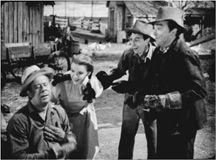
2.14 … the earlier scene in which the others teased Zeke for being afraid of pigs.
A CLOSER LOOK
PICKING OUT PATTERNS
In studying film as an art, you might sometimes wonder: Are all the patterns of form and style we notice really in the film? Do filmmakers actually put them there, or are we just reading them in?
When asked, filmmakers often say that their formal and stylistic choices aim to create specific effects. Hitchcock, a director who had an engineering bent, planned his stories carefully and chose techniques in full awareness of their possibilities. His film
Rope
confines the action to a single apartment and presents it in only 11 shots.
Rear Window
limits the action to what the hero can see from his apartment. In these and other films, Hitchcock deliberately created formal and stylistic challenges for himself, inviting his audience to come along. Most directors aren’t so adventurous, but throughout this book, we’ll include comments from filmmakers that show how the ideas we present are part of their working craft.
Sometimes filmmakers work in a more intuitive way, but they still must choose one story development or another, one technique or another. The finished film can have an overall unity because the momentary choices tend to mesh. Joel and Ethan Coen, the brothers who created
Blood Simple, Raising Arizona,
and
Fargo,
say they don’t set out with a particular style in mind. As Ethan puts it, “At the point of making the movie, it’s just about making individual choices.” Joel picks up the thread:
… about the best way to tell the story, scene by scene. You make specific choices that you think are appropriate or compelling or interesting for that particular scene. Then, at the end of the day, you put it all together and somebody looks at it and, if there’s some consistency to it, they say, “Well, that’s their style.”
CONNECT TO THE BLOG
In “Do filmmakers deserve the last word?” we suggest why we should always be cautious in accepting claims filmmakers offer.
Even if the Coens don’t map out every option in advance, the finished films display distinctive patterns of form and style
(
2.5
,
2.6
).
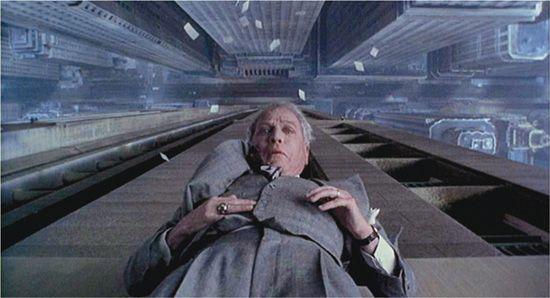
2.5 In the
Hudsucker Proxy,
the boss dangles above the street in a very steep, centered-perspective composition.
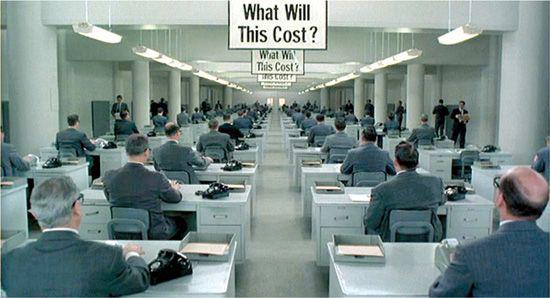
2.6 The same sort of composition is used to show the impersonal layout of desks in the Hudsucker company.
Professionals pay attention to other filmmakers’ formal and stylistic choices. While watching Stanley Kubrick’s
The Shining,
Nicole Kidman pointed out how the composition of one shot had both an immediate point and a long-range story purpose
(
2.7
):
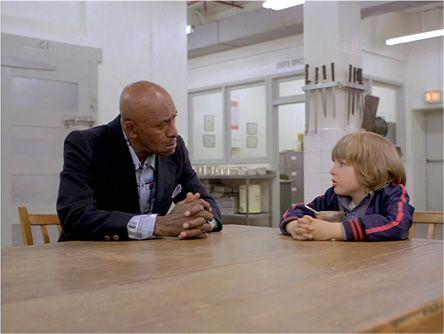
2.7 In
The Shining,
an early scene in the Hotel Overlook kitchen displays the telepathic rapport between Halloran and Danny, whose parents are caretaking the hotel for the winter. The knives are a natural part of the kitchen set but are aligned above Danny.
Here, in this scene, look at how there is this rack of knives hanging in the background over the boy’s head…. It’s important because it not only shows that the boy is in danger, but one of those very knives is used later in the story when Wendy takes it to protect herself from her husband
[
2.8
].
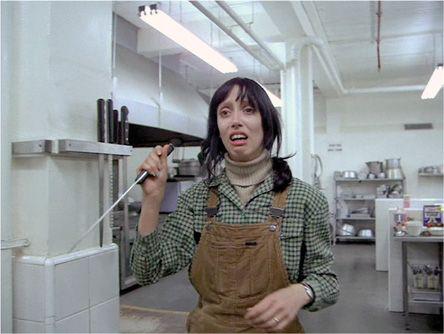
2.8 Later Danny’s mother, Wendy, goes to the same knife rack, seen from a different angle, to grab a weapon.
Kubrick told Kidman that a director had to repeat story information so that the audience could keep up. In other words, the pattern helped organize the film and in doing so shaped the viewer’s experience, if only unconsciously.
Kubrick’s comment points up another reason we can have some confidence when we pick out patterns. A filmmaker doesn’t create a movie from scratch. All films borrow ideas and storytelling strategies from other movies and other art forms. A lot that happens in films is governed by traditional rules, usually called
conventions.
When Kubrick shows us the knives behind Danny, he’s following a very old storytelling convention: prepare the audience for action that will come later. In contrast,
The Hudsucker Proxy
is a satirical comedy, and the perspective in
2.5
and
2.6
follows a convention of using exaggeration to create humor.
Very often, patterns in one film resemble patterns we’ve seen in other films. Even when filmmakers don’t explain what they’re doing, as experienced viewers, we can notice how they treat familiar conventions of form and technique.
Motifs can assist in creating parallelism. The viewer will notice, and even come to expect, that every time Dorothy meets a character in Oz, the scene will end with the song “We’re Off to See the Wizard.” Our recognition of parallelism provides part of our pleasure in watching a film, much as the echo of rhymes contributes to the power of poetry.
A film couldn’t rely only on repetitions. AAAAAA is rather boring. There must also be some changes, or
variations,
however small. Thus difference is another fundamental principle of film form.
We readily understand the need for variety, contrast, and change in films. Characters must be differentiated, environments delineated, and different times or activities established. Even within the image, we must distinguish differences in tonality, texture, direction and speed of movement, and so on. Form needs its stable background of similarity and repetition, but it also demands that differences be created.
This means that although motifs (scenes, settings, actions, objects, stylistic devices) may be repeated, those motifs will seldom be repeated
exactly.
Variation will appear. In
The Wizard of Oz,
the three Kansas hired hands aren’t exactly the same as their “twins” in Oz. Parallelism thus requires a degree of difference as well as striking similarity. When Professor Marvel pretends to read Dorothy’s future in a small crystal ball, we see no images in it (
2.9
). Dorothy’s dream transforms the crystal into a large globe in the Witch’s castle, where it displays frightening scenes
(
2.15
).
Similarly, the repeated motif of Toto’s disruption of a situation changes its function. In Kansas, it disturbs Miss Gulch and induces Dorothy to take Toto away from home, but in Oz, his disruption prevents Dorothy from returning home.
